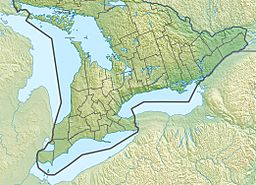Kasshabog Lake (Ontario) facts for kids
Quick facts for kids Kasshabog Lake |
|
|---|---|
| Location | Peterborough County, Ontario |
| Coordinates | 44°37′53″N 77°57′53″W / 44.63139°N 77.96472°W |
| Type | Lake |
| Part of | Great Lakes Basin |
| Primary inflows | North River |
| Primary outflows | North River |
| Basin countries | Canada |
| Surface area | 2,000 acres (810 ha) |
| Average depth | 15 ft (4.6 m) |
| Max. depth | 78 ft (24 m) |
| Shore length1 | 47 mi (76 km) |
| Surface elevation | 860.2 ft (262.2 m) (summer) 858.5 ft (261.7 m) (winter) |
| 1 Shore length is not a well-defined measure. | |
Kasshabog Lake is a small lake in Havelock-Belmont-Methuen, Peterborough County, in central Ontario, Canada. It is part of the Great Lakes Basin. Many people have cottages here. It's a popular spot for fishing, and there are also marinas and lodges.
Contents
Discovering Kasshabog Lake's Location
Kasshabog Lake is about 22 km (14 mi) north of the town of Havelock. The lake gets its water from several smaller lakes. The main river flowing into the north side and out of the south side is the North River. This river then flows into Belmont Lake. From there, the water travels through the Crowe River and Trent River before reaching Lake Ontario.
The lake has many islands and bays. One of these is MacDonald (Bill's) Bay. Even though it looks separate, it is connected to the main lake.
Many people enjoy spending time at Kasshabog Lake. In 1978, there were 16 homes and over 500 cottages around the lake. MacDonald Bay alone had 81 cottages. The small community of Kasshabog Lake is located on the west shore.
Understanding the Lake's Water
The water in MacDonald Bay changes completely about twice a year. The rest of Kasshabog Lake's water changes about once a year. This is called "flushing."
Kasshabog Lake has soft water that is slightly acidic. It has a low amount of color. The water's hardness and other levels show that the lake mixes well. Different layers of water temperature were found in most of the bays. The water is quite clear throughout the lake. This means the lake is "mesotrophic," or moderately rich in nutrients.
The amount of dissolved oxygen in the lake's water slowly decreases as you go deeper. This happens because organic matter at the bottom of the lake breaks down. Scientists did not find large amounts of nutrients building up at the bottom of the lake.
The tiny plants floating in the water, called phytoplankton, showed that the lake is "unenriched." However, the tiny animals, called zooplankton, suggested the lake is "moderately enriched."
Popular Fish in Kasshabog Lake
Kasshabog Lake is a great place for fishing! The most popular fish for sport are:
- Largemouth Bass
- Muskellunge
- Smallmouth Bass
You can also find other fish like Rock Bass, Perch, and Walleye (also known as Pickerel).
Tornado Event in 2002
In the summer of 2002, a tornado hit the Kasshabog Lake area. It was likely a weaker tornado, either an EF0 or EF1. The tornado caused damage to trees and a few houses.
Fanwort: An Invasive Plant
Fanwort (Cabomba caroliniana) is an aquatic plant that grows year after year. It is considered an invasive species. This means it can spread quickly and harm the local environment.
The first time fanwort was officially found in Ontario was in the summer of 1991. It was in the North River, just downstream from Kasshabog Lake. This is the only known established population of fanwort in Canada. Fanwort is a popular plant for home aquariums. It was probably introduced to the lake when someone dumped their aquarium contents into the water.
Environmental Concerns Near Kasshabog Lake
In August 2012, health officials in Peterborough County issued a health warning for people living near Kasshabog Lake and Bottle Lake. This was due to concerns about a company called Unimin Ltd.
In February 2013, the Ministry of the Environment released a study about air quality near Kasshabog Lake. The report stated that Unimin was releasing air contaminants. These contaminants were causing problems like:
- Harm to the natural environment.
- Damage to property.
- Discomfort to people.
- Loss of enjoyment of property.
The report also found that dust from Unimin's operations was violating air quality rules.
People living around the lake also complained about noise from the mine. They said the noise was louder than what a report for Unimin had claimed.
Following orders from the Ministry of the Environment, Unimin started a plan to cover its waste areas with plants. Aerial photos showed good progress at one site. However, at another site, the Nephton tailings area, less progress had been made.
On July 22, 2013, dust was seen coming from the Nephton tailings area. People took videos and photos to show this. In response, the Ministry issued an order to Unimin. They had to update their dust control plan and add more controls to stop dust from leaving the area. The Ministry stated they were committed to solving the problem and planned more inspections.



